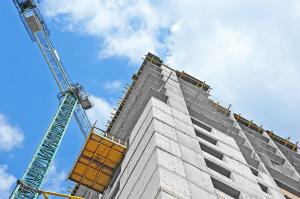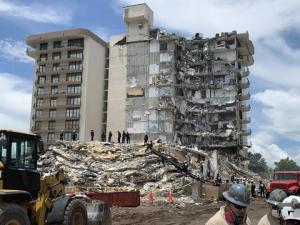
Laboratories Predict the Safe End-of-Life for Concrete Building Structures
Learn about the role material testing labs play in investigating concrete structural failures and what you can do to keep them safe.
The Growing Crisis Of Reinforced Autoclaved Aerated Concrete (RAAC) Buildings In The UK
UK news in recent weeks has been dominated by the news that over 50 schools won’t be able to reopen in the fall term due to safety concerns that flat roofs and other key structures built from reinforced autoclaved aerated concrete (RAAC) decades ago could suddenly collapse.
RAAC, which also goes by the names “aerobar,” “aircrete,” and “bubbly” concrete, was originally pioneered in Sweden. When it was introduced in the UK in the 1950s, RAAC was considered an innovative, lightweight, and lower-cost alternative to traditional concrete for use in applications such as flat roofs until its use was discontinued in new structures during the mid-1990s.
Why has this become a crisis, critics might ask, given that from the beginning, RAAC was known to have a finite lifespan of circa 30 years?
One possible explanation is there may be confusion between the economic lifespan of a structure and the actual physical lifespan of structurally sound, safe structures.
Many buildings are said to have an economic lifespan of a certain number of years; 40 years is typical, but future retrofits can usually be updated and recertified to provide additional decades of service.
Unfortunately, structures built with RAAC appear to fall outside this common understanding of a building’s lifespan.
Material testing laboratories confirm that as the RAAC material reaches the end of its useful life, it can become inherently dangerous and subject to sudden failure, especially if there has been water intrusion or inadequate reinforcement added during construction. The risk of sudden collapse without warning is the justification for closing schools with roof structures built with RAAC.
NIST Investigates The Champlain Towers South Collapse Near Miami Beach
Fortunately, there do not appear to be any structures built with RAAC in the United States. However, material testing labs are called in to evaluate the soundness of existing concrete structures, and, sadly, sometimes, they are first called to the scene only after a fatal collapse occurs.
Tragedy did occur two years ago in Surfside, Florida (located just north of the Miami Beach city line), where the Champlain Towers South condominium tower partially collapsed in a matter of minutes, costing the lives of 98 residents and guests.
After the collapse, accident investigators from the National Institute of Standards and Technology at the U.S. Department of Commerce, commonly known as NIST, secured the site as rescue and recovery operations concluded to capture important evidence that could shed light on the underlying causes of the concrete tower’s partial collapse.
(Readers of our articles may recall we also wrote about NIST’s involvement in cyber security protection for businesses.)
The approach that NIST investigators take is very similar to that taken by the NTSA after an airliner crash: every relevant piece of structure that could hold evidence of points of failure was measured and documented on-site, and key items were then transported to a large hanger-like structure where NIST material scientists and accident investigators could piece together what happened.
In June 2023, NIST officials presented their preliminary report on the Champlain Towers South collapse. The report was able to eliminate several potential causes of the collapse (including an explosion, or a vehicle impacting a support column in the parking structure), but a couple dozen hypotheses remain open for investigation.
Among these, NIST investigators are focused on areas of the original design that appear to provide only half of the structural strength required by 1981 building codes, poor placement of concrete rebar in the structure, the extra weight of heavy materials added to the building since it was constructed, and photographic evidence of major cracks and concrete spalling found in the months prior to the collapse.
Material Science Research And Accident Reconstruction Points To 10 Factors That Can Help Extend The Safe, Useful Lifespan Of Concrete Structures
Laboratory research by material scientists investigating past failures has revealed some regular patterns of bad design, inferior construction, and inadequate maintenance practices that can effectively shorten the useful lifespan of concrete structures – potentially resulting in sudden failures causing a disastrous loss of life.
Here are ten points to consider:
1) Avoid Construction Drawing Design Shortcomings Or Consequential, Unapproved Changes During Construction
One of the concerns that NIST investigators have expressed about the Champlain Towers South collapse was whether the design captured in the architect’s original construction drawings was sufficiently robust to support the structure, as well as whether the then-current 1981 building code requirements were adequate.
Building accident investigators have also found that fatal failures in concrete structures can occur when design changes are made during construction. The concrete walkways traversing the multi-story tall Hyatt Regency in Kansas City are a useful, if tragic, example. Investigators found that a switch during construction to a series of interconnected support rods during construction (rather than the single uninterrupted rods originally specified) caused the walkways to collapse during a gala event in 1981, killing 114 people.
Dangerous design changes can also happen years after initial construction, for example. after renovations or additions to the structure. An example of this is the 1995 collapse of the Sampoong Department Store shopping mall in Seoul, South Korea, which claimed 502 lives. Accident investigators point to actions by the developer, who added multiple stories to the existing structure, which was not capable of supporting existing loads spanning across wide open areas of the department store.
(Of course, structural failures typically have more than one root cause. For example, there were significant changes made in the design of San Francisco’s Millennial Tower’s foundation that we’ll discuss that detail below in point #5.)
2) Stop Poor Construction Workmanship Practices And Use Of Inappropriate Or Inferior Quality Materials
NIST investigators are concerned that the concrete support piers of the Champlain Towers South building were built with inappropriate rebar connections to the poured concrete floor. In some cases, there may have been too little rebar, in other cases, the rebar may have been bunched too closely together, providing little room for the concrete to affix to the connection.
Read more...
Julia Solodovnikova
Formaspace
+1 800-251-1505
email us here
Visit us on social media:
Facebook
Twitter
LinkedIn
EIN Presswire does not exercise editorial control over third-party content provided, uploaded, published, or distributed by users of EIN Presswire. We are a distributor, not a publisher, of 3rd party content. Such content may contain the views, opinions, statements, offers, and other material of the respective users, suppliers, participants, or authors.



